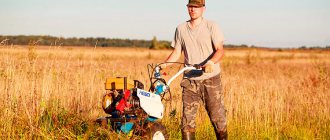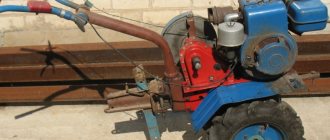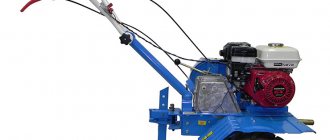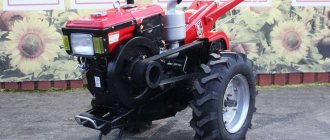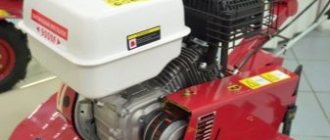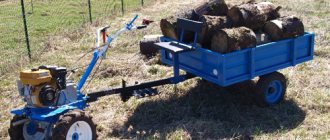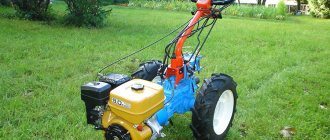One of the main assistants to a person when running a personal subsidiary plot is a walk-behind tractor. Its main purpose is to plow the land. This is quite expensive equipment, and in order not to spend money on such highly specialized equipment, it is enough to purchase an additional lug, which will expand the range of applications of the walk-behind tractor.
The industry produces a wide range of lug models. Some of them are universal, suitable for many walk-behind tractors, while others are narrowly targeted, suitable for a specific brand.
general information
By design, these devices are wheels with spikes. Today there are many different device transformations, and you should choose them wisely. To a large extent, the quality of work is determined by the weight of the unit. The most functional awnings can only be hung on heavy walk-behind tractors or medium-weight units. If the unit is of high quality and does not give the desired result, you need to additionally purchase wheels with lugs for it.- Standard devices are metal wheels with spikes that dig into the ground and engage the walk-behind tractor with it. To make devices yourself, you will need to know their structure, which drawings and diagrams will greatly help with. You will need to determine the diameter of the canopy, select the material of manufacture, and, of course, select the necessary tools. The first thing you need is a welding machine and an angle grinder.
- First of all, we decide on the size of the devices. Their height and width depend on the tasks for which the hooks are mounted on the walk-behind tractor. You also need to take into account the requirements for the weight of the devices, because the wheels are put on with them to improve the traction of the walk-behind tractor with the ground. This requires wheels of considerable weight, which a walk-behind tractor may lack. The minimum weight of wheels is 20 kg. If necessary, weights are hung on the soil hooks. This is necessary to achieve better results, or is used when the weight does not reach the norm.
This is interesting: Test drive tractors - choose the best
Varieties
The modern agricultural machinery market offers a wide selection of different wheeled models, classified according to several criteria. The main criterion for distinguishing lugs is their design.
There are two types of wheel lugs.
The first is a product made in the form of one or more metal rims welded together, equipped with cone-shaped spikes or corner plates welded at a certain angle. This design is installed instead of the original wheels, and fastening occurs using special brackets. The advantages of this type include high efficiency when cultivating land, and good maneuverability of the unit. The downside is the need to “change shoes” of the walk-behind tractor, which is a rather lengthy and labor-intensive process.
The second type is represented by lugs, made in the form of metal attachments, which are installed on top of ordinary wheels and do not require installation on the axle of the walk-behind tractor. Structurally, such models can be made in the form of chains or rims equipped with metal spikes. Externally, such models vaguely resemble ordinary anti-slip chains for cars.
This type of lug is especially popular among SUV owners and has proven itself well on broken, slushy roads with large amounts of dirt and clay. The advantage of this type of lugs is quick installation and low cost compared to metal wheels. The disadvantages include slightly lower cross-country ability and the need for additional use of weights.
The next classification criterion is the compatibility of lugs with various equipment. According to this criterion, special and universal devices are distinguished. And if the former are intended for a specific model of agricultural or road equipment, then the latter are compatible with most of them and can be installed on almost any unit. The advantage of specialized samples is higher efficiency and versatility, and the advantages of universal ones include their practicality and the ability to be used in relation to any equipment. In addition, such models are much easier to sell if they are no longer needed.
Description and sizes of hooks
Heavy walk-behind tractors are most suitable for working on heavy soils and, accordingly, hooks with a larger width and height are more suitable for coupling the unit with virgin soil or very neglected soil.
For highly complex work, weights are attached to the wheels. The dimensions of the hooks vary between 310-700mm in height and 100-200mm in width. The Salyut walk-behind tractor is suitable for lugs of 500×100 mm and 500×200 mm. The latter are functional together with the plow. You can buy the same size with a sand-filled weighting agent so that the mounted plow plows the soil deeper. If you have 500x200 hooks, you can make the weight yourself. Wheels with hooks measuring 700x130 mm are put on the walk-behind tractor to work with hillers, flat cutters and potato diggers.
Lugs for "Zubr"
In addition to those described above, the heavy Zubr JRQ78 and 79 walk-behind tractor can easily accommodate 700×100 mm hooks. Their width is smaller, and, in addition to heavy ones, they can be used with medium-heavy walk-behind tractors.
The hooks for the Zubr will fit the Neva. Hooks of this size are in great demand , precisely due to better compatibility. Wheels 700×200 can only be put on heavy units, and they are intended for processing virgin soil. Wheels 700×100 are suitable for the average needs of a farmer; they can be safely stored and mounted on another walk-behind tractor when the existing one becomes outdated, even one with weaker power. 700x100 lugs will cost about $70.
How to choose
Selecting a hook is complicated by the wide assortment in stores, but don’t get lost, everything is quite simple if you follow the recommendations. The main parameters of wheels are width, height and runners.
All manufacturers indicate the diameter, which is calculated from the edges of the studs. And their length can be 3 cm in height.
If the user of a walk-behind tractor has not bought lugs before, you need to trust the consultants, naming the parameters and name of the block - this way you will be able to buy a high-quality and suitable model.
Lugs for the Neva walk-behind tractor
Metal wheels are designed to solve two problems - plowing (working with a plow) and cutting ridges with hilling. Therefore, you need to understand the wheels based on the above functions:
- Plow. The wider the wheel, the more stable the machine moves with the plow installed. It must be taken into account that the height of the wheel greatly affects the speed of work. It is not advisable to buy samples larger than 500 mm for a plow. For plowing, a diameter of 420 mm or less is suitable. For good traction, three-strip lugs are needed. Light soil will seep through the skids until the toe reaches hard ground. At this point he will push off and be able to move forward. It is inconvenient to work on single-lane or rubber wheels; they slip, and soil flies into the teeth - it gets stuck and slows down the device.
- A single hiller cuts the ridges and hills at the same time. You need single-lane wheels that fit under the wing of the walk-behind tractor. The optimal size is 425 mm with a width of 130 mm. The wheel is fixed without adapters onto the shaft so that the minimum track is occupied. If the soil is difficult to cultivate, it is advisable to weigh it down with special sheds or a regular weight - any weight that is on the site will do.
- A double hiller is needed to work on high wheels - 500-600 mm. One hiller is installed in one track. Two specimens, when tightly coupled, create parallel ridges. Working with such a hiller is advisable if the garden is more than 10 acres. This refers specifically to the vegetable garden, there is no need to take into account the entire plot.
The information provided is enough to understand how to choose the right lugs for a walk-behind tractor. Even without sufficient skills, you can buy accessories that will last a very long time.
In the video below, an experienced walk-behind tractor owner explains how to choose the right lugs.
The simplest holds
To make it you need the following:
- Steel sheet 4-5mm thick for wheel rims.
- Steel sheet 6-8mm thick for hooks.
- Welding machine.
- Bulgarian.
- Drilling machine or powerful drill.
Two identical disks are cut from a thinner sheet. A hole is made in the center for the hub and mounting on the wheel studs. Saw-tooth projections 10 cm deep are cut along the outer edge. Triangular hooks with cut corners are cut out of a thick sheet. They are welded strictly perpendicular to the sawtooth cuts.
Despite their unsightly appearance , homemade hooks made using this method have a serious advantage - they are heavy enough to provide strong grip even on a muddy or loose surface. Moving on dirt roads is out of the question; such wheels are intended only for work in the field.
Another economical option is to make it from a Ø15mm steel circle. The steering wheel from the valve on the main gas pipeline can be used if a pair is found. The hooks are welded to the outer rim, and the hub is attached to the center.
For the next design you will need car wheels. This manufacturing option for a homemade walk-behind tractor is optimal. When designing, standard car wheel hubs are provided, and the entire set of four wheel rims is purchased. One pair is equipped with tires, and the second is needed for heavy soil.
A steel corner of 50-60 mm is taken and cut into pieces that are slightly wider than the disks. In the middle of one side, a triangular sector of 60° is cut out with a grinder.
The corner is heated with a gas burner and bent along the cutout. The joint can be slightly tacked by welding to provide additional rigidity. The resulting blanks are welded to the outer side of the disk, and an equal distance is maintained.
The assembly is repeated on the second disk, do not forget about the same distance between the corners. Now you can quickly replace rubber wheels with steel hooks, and there will be no problems with the seat, because the disks are the same.
The design of the wheel rims can be simplified. To do this, the horizontal part (rim) is cut off and steel plates are welded on. This option is suitable for frequent wheel changes on the same type of hub. Discs are selected accordingly.
Weighting the walk-behind tractor body
In some cases, the weight of the wheel weights is not enough. Since it is not recommended to overload the axle, weight is added to the unit body. This can be done in different ways. The best option is to attach the removable steel frame directly to the walk-behind tractor. The basis can be a frame, a gearbox or a niche for installing a battery.
The increase in body mass is carried out in the following sequence:
- Determination of the center of gravity of the unit. Creating a frame project.
- Welding bolts with a diameter of 12 mm and a length of at least 10 cm to the gearshift housing and to the steering wheel bracket of the walk-behind tractor.
- Welding a frame from a corner. Making mounting holes for bolts in it.
- Fitting the frame to the frame. Drilling holes in it that correspond in location to the holes on the frame.
- Cleaning the frame from dirt and rust. Painting the product and fixing it to the frame.
- Making cargo to fit the size of the frame. You can find the necessary parts at a scrap metal collection point, where the material will be immediately cut into fragments of the required size.
The weights are secured to the walk-behind tractor using welding or bolted connections. The second option takes longer to implement, but is more practical in the long term. The need to remove additional weight arises when transporting the unit or performing light work, when excess pressure on the ground is contraindicated.
Functional purpose
The first thing you need to know before purchasing equipment is its functionality. Lugs are no exception. Lugs for walk-behind tractors successfully fulfill the following purposes:
- • improving the quality of adhesion to the ground;
- • increasing the weight of the walk-behind tractor for greater stability and the possibility of using various attachments;
- • additional tillage;
- • facilitating the movement of a walk-behind tractor with a load uphill on soft soil.
Thus, it is immediately clear that it is necessary to buy lugs for a walk-behind tractor. Without them, the walk-behind tractor will not be a completely universal unit. In order to understand which lugs are required for which walk-behind tractor, it is worth studying their features by type of machine. Only the right lugs will perform their functions efficiently.
This is interesting: Hydraulics for a tractor - operating principle, manufacturing, video
Technical characteristics of the Neva MB 2 walk-behind tractor
This type of special equipment is usually distinguished by the following technical characteristics:
- six horsepower and 4.5 kW;
- fuel tank 3.8 liters;
- three gears (2 forward, one reverse);
- working volume – 205 cubic centimeters;
- the engine accepts 92 and 95 gasoline;
- engine speed (23-42 – first gear, 89-160 – second).
The device is equipped with a trailer for a Neva MB 2 walk-behind tractor, as well as other attachments for soil cultivation and cultivation.
Important! For the Neva MB 2 walk-behind tractor, there is a large number of attachments (milling cutters, plows), this is due to the wide distribution of the model.
Combined design
If the equipment is homemade and the soil is not too difficult, the wheels should be appropriate.
You can make hooks using tractor protectors. We take halves of wheel rims from a Zhiguli car . We choose tires with good tread from the tractor. We cut off the sides, we get a rubber closed ring with a good protector. We open the halves of the wheel rims and, after laying the tires, twist them firmly. With such lugs, you will be able to move along a compacted dirt road without fear of loosening it. On the soft soil of a plowed field, the wheels will not fail, but the traction force will be less than in the case of the metal version.
If it is necessary not only for the wheels to be grippy, but also to additionally loosen the soil in the rut, knife-type hooks are made. You can create a homemade rim to mount them or weld them to the rims. The only drawback of the blade design is that it does not allow you to move the walk-behind tractor in the usual way.
When loosening in spring together with traditional attachments, the width of the soil processed per pass will double, which will save a lot of time.
Options for wheel design drawings for a walk-behind tractor
Factory configurations of wheels for a motor cultivator are classified according to the number of axles, as well as the principle of traction. Manufacturers produce home mini tractors, the design of which involves the movement of the unit due to:
- two wheelsets;
- paired wheel structure on one axle;
- one drive wheel;
- on three wheels.
Single-wheel mechanisms are often equipped with additional devices on the axle, which also serve as support for the structure. Analyze the model of your home cultivator to improve its functionality. Choose a durable, reliable material or a suitable base for making homemade chassis elements.
Four wheel option
Small-sized agricultural tractors on four wheels are a miniature of a similar vehicle without a cabin. The configuration of the models allows the user to move on a walk-behind tractor.
To improve the factory configuration, you can replace only the drive pair or change all the disks. Choose one of the options to improve the performance of home agricultural equipment:
- equipping factory tires with additional protectors;
- putting new tires with a textured pattern on the wheels;
- installation of wheelsets of different radii on the axles - larger ones under the mechanisms, smaller ones under the driven part;
- installation of car wheels.
Important! Designing wheels is an important stage in improving a walk-behind tractor, at which it is necessary to make accurate calculations of the optimal dimensions, arrangement of elements, and locations for drilling fasteners.
Four-wheeled walk-behind tractors are classified as heavy-duty models. A number of machines are configured with non-removable wheel elements. Before modifying a mini tractor, make a drawing according to which you plan to improve.
On one wheel set
Two-wheeled motor cultivators are equipped with one axle with a pair of wheel elements. The platform with the installed engine is controlled by the user using handles. Installing a passable wheelset will solve the problem with:
- slippage;
- slippage;
- filling the poorly expressed tread pattern with earth;
- poor handling;
- insufficient plowing depth, etc.
Draw a sketch of one element on paper yourself or make a drawing in a computer program. In the figure, indicate the diameter of the disk, the location of the holes for the axle, fastenings, and their dimensions.
With one driving wheel
Single-wheeled cultivators are devices in the form of a wheel element in a tire with a pronounced tread. The speed of work and efficiency when performing farming work depend on the permeability of the disk.
When preparing a drawing for replacing the drive wheel, use the following recommendations:
- select the diameter of the wheel element similar to the factory configuration;
- choose materials with greater weight when making a wheel yourself;
- replace the rubber with a more textured and wider one.
The walk-behind tractor on one wheel is controlled by manual manipulation. It will be easier for you to drive a design with a wide wheel and a powerful tread.
Three-wheeled models
On small-sized agricultural tractors for cultivating a summer cottage with three wheels, the front element performs the function of following a given trajectory. The rear wheel pair is supplied with torque from the unit engine. In most models, the chassis located at the front is made of a larger diameter.
To design the replacement of wheels on a single-axle small-sized tractor, use the following recommendations:
- calculate the same radius of the wheel and tire that is provided in the factory configuration. Installing a smaller or larger wheel in diameter will make the mechanisms work incorrectly;
- make identical wheel elements. Replacing wheels with different tread patterns or different weights will complicate the use of the mini tractor.
When making a drawing with your own hands, take as a basis the model designed by the manufacturer. Consider the full radius of the elements. You can design a disc with a smaller diameter, but install thick tires on it, and vice versa.
Lugs for popular walk-behind tractors
There are many popular walk-behind tractors that are most often purchased by users. The inventory for them differs in type of material, size, and manufacturer. If we consider from the side of the model range, then lugs can be further classified according to the type of fastening. Whatever product you choose, the design of the attachment should be such that the metal does not touch the walk-behind tractor, and its bends are directed in the same direction where the equipment is moving. It is worth considering which lugs are best suited for different brands of walk-behind tractors.
- "Neva". With this technique, it is best to use attachments from KMS, since each element individually weighs 12 kilograms. The diameter of the lugs is 460 mm, so the efficiency of work can be traced regardless of the type of soil. Products under the KUM brand are also worthy of attention; they should be used for hilling or deep plowing.
- "Salute" or "Agate". The self-cleaning option from is ideal.
- "Oka." In this case, it is best to use the DN-500*200 attachment.
- Belarus 09N and "Agros". Products for this technique differ in the method of fastening, since the bent top must face the direction of movement. PF SMM produces high-quality products.
- Aurora. For this brand, it is best to use branded lugs for working on open ground.
- "Mole". The best equipment for equipment under this brand is produced by Mobil K. A special feature is the need for additional use of extension cords.
- "Patriot". You can use the lug S-24, S-31 MB and others for the walk-behind tractor. The advantage of this technique is that it is not difficult to find attachments for it.
- "Farmer". It is possible to use the Elitech model 0401.000500, you can find products a little cheaper, since there are enough of them on the modern market - “Khutor”, “Viking”. "Favorite".
Any of these models provides high-quality grip on the ground. If the user is trying to save money, it is better to consult with a specialist in more detail as to whether the selected attachment is suitable for the equipment used. As a rule, lug manufacturers specify in the operating instructions the brands and models of walk-behind tractors with which this product can be used.
The best premium lugs
Better models are usually installed on large, high-power walk-behind tractors. The cost of the equipment is significantly higher than other models, but the lugs will last for many years. Heavy alloys are used for their manufacture, which has a positive effect on strength.
- K MBK0011766 - a special feature of the model is high-quality welding of studs. The canopy is suitable for all types of work with a motor cultivator and provides good grip on the ground. Weight - 16 kg, diameter - 46 cm. Among the advantages - large weight and build quality. Disadvantages - it is compatible with a small number of walk-behind tractors, and the hub for mounting will have to be purchased separately.
- MB Aurora 11749 are all-metal wheels with powerful spikes that go deep into the soil. Suitable for installation on walk-behind tractors that can withstand high loads. The weight is average, so sometimes you need to use weights. Weight - 7 kg, diameter - 40 cm. The advantages include very large spikes, reasonable price and high-quality metal, which ensures a positive service life. The downside is its low weight, which complicates the work and requires additional investment.
Aurora 11749 costs an average of 4,000 rubles, but it is a good investment; its manufacturing features make the GB durable and reliable
What sizes should you take?
On the Internet you can find many drawings and diagrams for making lugs yourself. But what sizes correspond to which brand? Sometimes this is not indicated in the drawings.
So, the most common motorized cultivators are: Neva, Mole, Salyut, Oka, Bison, Centaur. Let's look at Neva walk-behind tractors.
The lug lugs for Neva walk-behind tractors are perfect for the Salyut and Favorit walk-behind cultivators. Dimensions for homemade tools for a walk-behind tractor: height - 34 cm, width - 11 cm. These dimensions are shown in the drawing, and all the small details that must be observed to work well with the ground are indicated. By the way, the lugs of the homemade version make a little more than the factory ones, because Difficult to accurately select the size. Dimensions for walk-behind tractors of other brands vary from 34 cm to 70 cm and above.
Let's look at the main functions of lugs on the Neva walk-behind tractor:
- Better quality plowing of land.
- The installed tools make the walk-behind tractor heavier and easier to use, which improves soil work and allows you to work with heavy mounted structures.
- This product helps you climb uphill with a full trailer in a fairly short time.
- The teeth catch small and large plant roots, tearing them out.
The best mid-budget
These products are very popular; they are in demand due to the good combination of price and quality. Judging by the reviews, the hooks last for many years.
Manufacturers select high-quality materials in production so that the lugs do not rust. They can replace the wheels of various models of walk-behind tractors, but first you need to carefully read the instructions to ensure compatibility.
- MINI DDE 44.04.25.00.00 is a small but useful lug designed for hilling. The spikes have a curved shape with an external sleeve.
- Tselina 10106 is an ideal option for a domestic walk-behind tractor. The canopy weighs 11 kg and is therefore suitable for almost all types of ground work. If necessary, it is possible to attach an additional plow. The spikes sit firmly on the hoops, which ensures long service life.
Other worthy models in the mid-price segment include MB from ]Patriot[/anchor], Tarpan, Farmer, and Champion. They are durable and easy to use.
Celina lugs (appearance)
Features of choice
For those who purchase universal lugs for a walk-behind tractor, it is only important to choose the right size. For those who want to have lugs for a walk-behind tractor of a certain model, it is necessary to approach the issue more responsibly.
The most common among mini-farmers is the Neva walk-behind tractor, for which it is worth starting with lugs. The width of the lugs is 43 cm, and the length of the part buried in the soil is 15 cm, which is quite enough for high-quality movement of the machine. The same lugs are used for the Neva MB walk-behind tractor. It is also worth noting the fact that it is quite possible to make homemade lugs for it, regardless of whether the Neva walk-behind tractor is marked MB-1 or MB-2.
Another type of common walk-behind tractor is the Salyut, which also needs lugs for itself. Grousers are primarily required to make the machine heavier, in order to increase traction with the ground, and to allow the use of a wider range of attachments. The width of the lugs is 50cm, and the deepening part is 20cm long. When it comes to lugs for the Salyut 100 walk-behind tractor, the dimensions will be the same.
They do not produce lugs for heavy-duty walk-behind tractors, and if necessary, owners make them themselves using various video instructions. Taking this into account, we can immediately say that making lugs for a walk-behind tractor with your own hands is quite simple and only requires accuracy, time and basic skills in working with metal. Only when a walk-behind tractor has high-quality lugs can it be called a full-fledged agricultural machine.
Types and types of wheels for Neva walk-behind tractors
Neva walk-behind tractors have a wide range of applications. However, regardless of what kind of attachment they will work with, they need wheels to operate them. This is the main working unit. And their choice must be approached with understanding. Let's figure out exactly what types of wheels are available for sale for the Neva walk-behind tractor.
Set of traction wheels 16x6.50-8
These wheels are installed when carrying out traction work with the Neva walk-behind tractor. Their characteristics are maximally adapted for this.
The tires are made in a tubeless version, which eliminates the risk of wheel failure due to the tube being overinflated and bursting. The working pressure inside is 2 atmospheres. The maximum load on one tire should not exceed 280 kgf. The weight of a set of wheels does not exceed 13 kg.
The outside diameter of the tire is 16 inches and the width is 6.5 inches.
Transport wheels 4.0x8
These wheels have a smaller diameter and lower tire pressure. Because they are intended primarily for transporting goods and are installed on a trailer.
They are only 4 inches wide and 8 inches wide. They are not large in height, but they are wide. Therefore, they have a large area of adhesion to the ground. This makes them ideal for transporting goods.
Wheel Tread Widening Kit
Sometimes it becomes necessary to lengthen the axle of a walk-behind tractor or trailer to work with any attachments or to install wheels (which do not have a bushing). And changing the axle completely is time-consuming and expensive. It is much easier to buy special extenders.
They make the rut bigger. Thus providing the opportunity to install wider wheels or a trailer.
The delivery set includes two extensions and two stoppers. This is a simple but effective design.
Buying tips
When purchasing such a large item, you should consider the following parameters:
- height;
- diameter;
- width;
- depth of penetration of spikes into the ground.
It is the size that plays a leading role when purchasing. If the lug is selected specifically for the model of equipment, then the issue of choice must be approached more carefully in the absence of experience and knowledge. Consultation is always required, otherwise the purchase will not be suitable. “Neva” is considered one of the most common walk-behind tractors used by farmers. The width of the attachment for this unit should be 430 mm. The metal plates that are immersed in the ground must have a height of 150 mm, this is exactly what is required to ensure the necessary quality of adhesion to the surface during operation.
On Salyut walk-behind tractors, the width of the element in question should reach 500 mm, while the depth of immersion of metal spikes on the surface is 200 mm. On MK-100 or MTZ-09 you can use a universal model. If you use heavier lugs, it becomes possible to attach more other attachments to the equipment, since its stability also increases.
It is worth noting that the size of suitable equipment is related to the class of machine on which it will be installed. If this is a walk-behind tractor in the heavyweight category, then you should take metal wheels with a diameter of about 700 mm. For lighter ones, from 250 to 400 mm are suitable; the most popular are considered to be 32 cm in diameter.
It is equally important to take into account the type of soil, since this will be what you will need to rely on when choosing the shape of the welded tenons. Arrow-shaped metal plates are a universal option, since the coupling point is made in the form of an angle, due to which the walk-behind tractor can grip even loose soil.
Most manufacturers of attachments in this category suggest the use of additional weights. This is especially important when working on loose soil, where the equipment begins to slip and sinks more. Additional weight is a means that increases the operating efficiency of light equipment. This product is presented in the form of small containers made of metal; if necessary, they are filled with sand, stones or other materials that are at hand.
The best inexpensive lugs
Users usually pay attention to budget models. They are cheap, but make you feel comfortable when working with the lug.
They also buy inexpensive awnings to get acquainted with additional features for the first time. After a breakdown, they are replaced with expensive ones that will last much longer.
A worthy option is KMS, suitable for walk-behind tractors "Neva", MB2, MB23, MultiAgro. Allows you to work on loose soil.
The KMS hook is one of the best on the domestic market in the middle price segment - it is durable and costs only 2,000 rubles
Thanks to the strong side ridges, it is securely fixed in the ground, creating stability in motion. Diameter - 46 cm, width - 21.5 cm. Fixation is carried out to the gearbox shaft.
The Lifan 430*200 product can be installed on domestic Salutes and Agates, Mole. The canopy is self-cleaning, but it is advisable to wash it after use. Diameter - 43 cm, width - 20 cm. Thanks to the weight of 17 kg, stability is created during operation.
It is used for plowing the land with a walk-behind tractor, as well as for loosening, harrowing, and hilling. It is fixed to the gearbox shaft using a bushing.
It is also advisable to pay attention to models, they are inexpensive, but have a number of advantages (according to reviews from real users).
Lifan 430*200 cost about 2000 rubles
Self-production from disks
You can make a lug yourself; for this you will need old car wheels. With the right approach to the process, such equipment turns out to be no less effective than purchased equipment, while it pleases with durability and efficiency. The manufacturing process may only seem complicated from the outside, but in fact it consists of simple steps.
- First of all, the master welds plates made of metal to the Zhiguli disks from the outside.
- At the second stage, the teeth are made. Steel will be required as the main material, since it is it that has the necessary qualities. The craftsman needs to cut the blanks to size. The length will depend on the type of walk-behind tractor; the heavier the equipment, the longer the spikes should be. For heavy walk-behind tractors this parameter is 150 mm, medium 100 mm, and light 5 mm.
- After manufacturing, the teeth are welded to the rim, while a distance of 150 mm must be maintained between them.
If you comply with the requirements, the result will be a quality product. Increased adhesion is possible if weights are used. Installation of such attachments is carried out in the same way as finished products, taking into account the design features of the walk-behind tractor.
From the video below you can learn how to make lugs for a walk-behind tractor with your own hands.
How to make lugs with your own hands
Homemade lugs for walk-behind tractors can be made from machine disks. If a farmer has an old car that is a pity to throw into a landfill, with whole disks and rims, then they can be used to make lugs for a walk-behind tractor from car disks.
For this you will need:
- rims;
- welding machine (or grinder);
- square plates;
- drawing or diagram of lugs for the walk-behind tractor (will make the work very easy).
So, to make lugs for a walk-behind tractor from machine disks, you need to weld an axle shaft to them, onto which bearings are then put. Square plates need to be welded to the car rims.
After the completed procedures, you need to make plates-teeth that will bite into the soil, providing the necessary adhesion to it. The teeth can be made from solid metal sheets by cutting the desired size with a welding machine or by welding small plates together.
The teeth are welded to square plates on disks at a distance of 15-16 cm from each other. A deviation of 2-3 cm is acceptable, but for better operation of the unit you must strictly follow the instructions in the drawings and diagrams.
If the old car is not available, but there is a used gas cylinder, then there is another way to make lugs for the walk-behind tractor with your own hands.
For this you will need:
- gas cylinder (used);
- grinder or welding machine;
- metal plates for teeth;
- drawings or lug diagrams of a walk-behind tractor of the required brand.
First you need to cut two disks from the cylinder, which will serve as rims for the wheels of the walk-behind tractor. Then, as in the first option, weld the square plates and the teeth to them.
Another option is to weld lugs from steel plates. For this you will need:
- steel layers 4-5 mm thick;
- steel layers 6-8 mm thick;
- welding machine or grinder;
- drill or hammer drill.
A thinner sheet must be cut into two disks, in the center of which holes must be made for the hub. Cut sawtooth waves along the outer edges, with a wave depth of 100 mm. Triangles with cut corners must be cut out of a denser steel layer and welded perpendicular to the waves. The design is ready for use.
Of course, such lugs differ in appearance from their counterparts, but they also have many advantages.
Features of operation of the Neva MB 2 walk-behind tractor
When using a Neva walk-behind tractor, a number of nuances and points requiring attention should be taken into account, namely:
- you should find out in advance the working volumes, as well as how much oil is in the walk-behind tractor;
- clarify what kind of gasoline to fill, since the service life of the equipment depends on the quality of the fuel poured in;
- It is important to take into account maintenance periods;
- you should know when to perform a full comprehensive service;
- During operation, it is not recommended to be very zealous and keep the device running for a long time;
- immediately after purchase, it is necessary to carry out a run-in on unloaded special equipment so that all the parts get used to it;
- After maintenance, it is also not recommended to immediately load the equipment.
Do not forget to prepare the walk-behind tractor in advance.
You should also take into account the fact that you should not allow the device to operate on residual fuel, since over time, impurities accumulate in the tank, which can damage the engine and shorten its service life.
Important! This type of special equipment differs from other devices, therefore the maintenance stages are established not by mileage, but depending on the hours rolled, which is why the time of use should be carefully monitored.
What gasoline is suitable for the Neva MB 2 walk-behind tractor
To ensure that the walk-behind tractor can operate without complaints for a long time, it is recommended to use high-quality fuel. 92 or 95 gasoline is poured here. Experts recommend periodically increasing the octane number if AI-92 is used, which allows you to clean the power plant from deposits. The manufacturer recommends filling in high-octane gasoline no more than twice a season, provided that the walk-behind tractor is used on a regular basis. If this type of equipment is used less frequently, then you can limit yourself to filling 95 fuel once a season.
Important! You should not alternate fuel too often, and, in addition, change the place of purchase, since the content of impurities in the fuel may differ at different gas stations.
This type of special equipment, such as a walk-behind tractor, is very popular among amateur gardeners, as well as commercial agricultural companies. Currently, there are various models and manufacturers of such equipment, but the most popular is the manufacturer Neva and its model MB 2. This unit has proven itself well due to its unpretentiousness and ease of maintenance.
In addition, a whole host of attachments and auxiliary equipment is available for sale for this walk-behind tractor, which allows you to operate the device in all possible senses. However, despite the reliability and quality, in order for this device to serve for a long time, it is necessary to regularly service the equipment, as well as install only high-quality parts and consumables.
Attachments for the Neva MB 2 walk-behind tractor
Depending on the tasks assigned, the following equipment can be attached to these devices:
- lugs (used for plowing);
- cutters (used for hilling);
- plow (usually used for loosening).
In addition to the usual fixed plow for the Neva walk-behind tractor, the plow can be used as a trailed component to simplify the soil cultivation procedure when loosening.
Important! The device can also be equipped with a water tank and a liquid sprayer to provide uniform watering.
grouser
This type of auxiliary components allows you to plow the soil. Processing is carried out using special shovels, which are connected in one chain. Thanks to this device, you can quickly plow the soil over a large area. The devices are hung on the device using a standard hitch with a walk-behind tractor.
Milling cutters
These mechanical elements are usually used for hilling. The devices are customizable. This type of device can be hung in two rows, which allows two furrows to be cultivated at once. In this case, this significantly saves time and energy costs.
This type of device is a conventional mounted plow, which is used to loosen the soil. After the plot of land has been covered, you can immediately plant the plants in cultivated soil. These devices are mounted as trailers. When processing, you should ensure that the plow does not go to the side.
How much oil to pour into a walk-behind tractor engine
It should be understood that in walk-behind tractors the oil is subject to periodic replacement not only in the engine, but also in the gearbox and transmission. Let's take a closer look at the quantity of this consumable:
- 1.3 liters of engine oil should be poured into the engine;
- oil is poured into the gearbox using a special dipstick;
- In the transmission, oil is also poured in accordance with the dipstick.
After pouring lubricant into the motor, you need to check its level. It should be located between the minimum and maximum.
Important! If there is a lack of lubrication, the engine life will be sharply reduced; if there is an excess of oil, a reduction in working life may also occur, since this liquid is not subject to compression.
